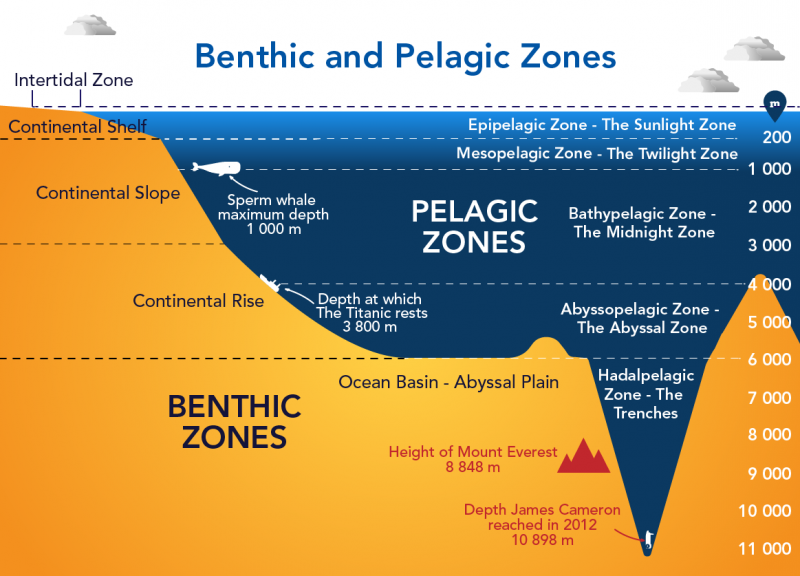What Is the Warmest Temperature Zone of the Ocean
The pressure is higher here it can be up to 1470 pounds per square inch 10100000 Pa and increases with depth. In the open ocean maximum temperatures occur north of the equator.
An area of the ocean surface with uniform temperatures created by the mixing of water by waves currents and tides.

. Sunlight Zone epipelagic zone Top ocean zone that has the most sunlight most life warmest temperatures and least pressure. Humans and many animals depend on the ocean. 0 650 0 200.
Between is the thermocline which is warmer at the top than the bottom. In some areas this surface temperature is relatively stable while in others it fluctuates depending on the season and thus the amount of sunlight received. At the base of this mixing layer is the beginning of the thermocline.
Top zone of the ocean The sunlight zone. It is also regarded as the warmest layer. Here are the oceans in order of their temperature.
Ocean temperature depends on the amount of solar energy absorbed. Which of the following is directly related to deep-ocean currents. The zone of maximum water temperatures shifts with the seasons but in only a few areas does it extend south of the equator.
The area-averaged temperature anomaly between 66N and 90N has reached a record of 58C 104F for January and 456C 82F for February Figure 1the warmest period in the Arctic for these two consecutive months since 1948 based on the National Centers for Environmental Prediction NCEP and National Center for Atmospheric Research NCAR reanalysis products. Tropical oceans receive a lot of direct overhead sunlight for much of the year so the water is warm. This ocean is bordered by Asia Africa and Australia and is the warmest in the world.
Which ocean temperature zone has the warmest water. What Chesapeake Watershed fish can survive the coldest water temperature. Evaporating water turns in to precipitation.
The ocean has three main temperature layers. The temperature of the ocean especially the surface varies from place to place and from season to season. Another hot area exists in the Red Sea where a temperature of 1328 degrees Fahrenheit has been recorded at a depth of about 6500 feet.
Water temperatures are the warmest. This is also called the midnight zone and the deep ocean. The map above is updated daily and shows the ocean water temperature as recorded on 15th Apr 2022.
Summer is the only time polar regions receive sunlight and even then. Since it does not connect to the Arctic Ocean the coldest ocean on Earth the. It alone makes up over 83 of the ocean and covers 60 of the Earth.
At midday it is practically fully lit by the sun hence called the sunlight zone. 60 KB Referencing Hub media. Ocean Sunlight Zone.
Because the deeper it gets the colder it get for instance. Aptly named for its position at the surface level this sunlight zone also called the surface zone or epipelagic zone extends downward 200 meters or roughly 5 of the oceans average depth. Name three ways life on earth depends on the ocean.
The upper warm and deep cold layers have the same temperature throughout. The University of Waikato Te Whare Wānanga o Waikato Published 30 June 2010 Size. Interaction with the wind keeps this layer mixed and thus allows the heating from the sun to be distributed vertically.
The most variable temperatures depending on location and proximity to the ocean surface which allows light and consequently heat to penetrate. Temperatures in the Mesopelagic zone range from 5 to 4 C 41 to 39 F. The sea surface temperatures range from as high as 97 F 36 C in the Persian Gulf to 28F -2C near the North Pole.
At depths of 3000 to 6000 metres 9800 to 19700 ft this zone remains in perpetual darkness. This ocean layer has the most visible light and warmest temperatures hence its nickname. Ocean temperature and currents affect climate and wind patterns.
Where would you find the warmest waters. Associated with the benthic zone is this that covers the deep-ocean floor and abyssal plains. 54 of the ocean lies in the Bathypelagic aphotic zone into which no light penetrates.
Water temperatures of the Indian Ocean range between 66 and 82 degrees Fahrenheit 19 to 30 Celsius on the oceans upper layer. The Indian Ocean has the warmest water temperature due to its geographical location and ocean currents. Its the thinnest layer accounting for just 5 of the ocean depth.
Deep cuts in the ocean floor that occur at the seam of two colliding plates at a subduction zone. Which of the following has a major role regulating global temperatures. The abyssal zone has temperatures around 2 to 3 C 36 to.
The waters of the Pacific Ocean comprise the worlds largest heat reservoir by far and it is the warmest ocean overall of the worlds five oceans. These variations in solar energy mean that the ocean surface can vary in temperature from a warm 30C 86F in the tropics to a very cold -2C 28F near the poles. The other oceans are the Arctic.
The sunlight zone would be warm because as its title states it is the warmest zone. Includes a thermocline and a pycnocline.

Ocean Zones Let S Talk Science



Comments
Post a Comment